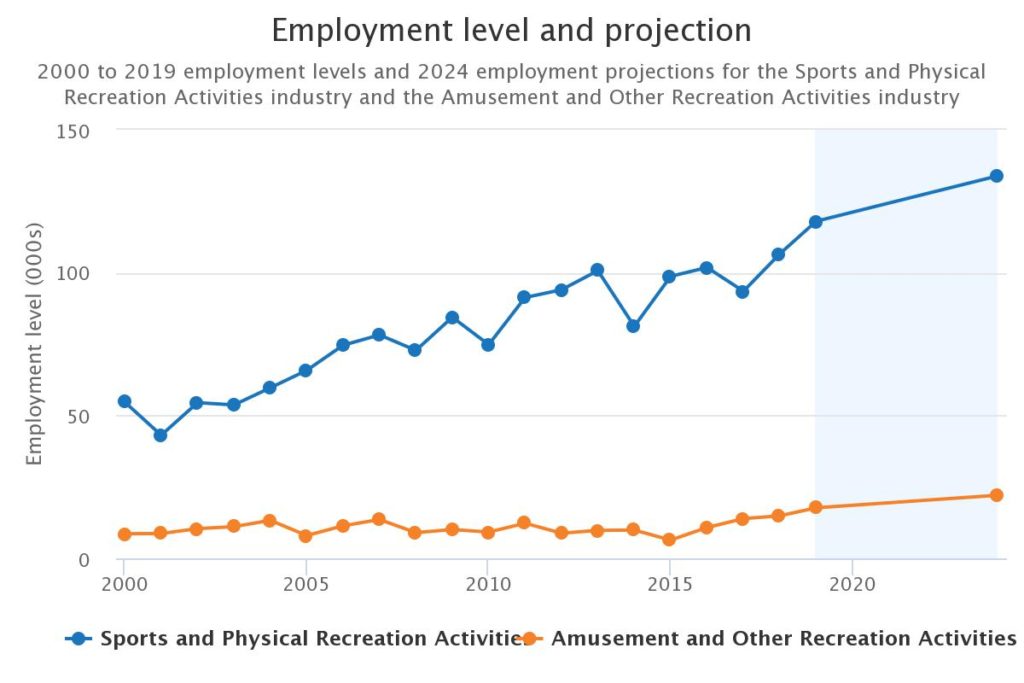I was lucky enough to attend our fitness industry associations recent information session in Brisbane, and it reinforced what I expected. The fitness industry is on the rise and becoming a Personal Trainer is a great idea.

The Importance of Exercise for Physical Health and Mental Wellbeing
The pandemic has already taught us many lessons and it will continue to, as we navigate a post-COVID world. A key learning, and one well overdue, is the importance of exercise for physical health and mental wellbeing. It has been both refreshing and reassuring to see and hear the Prime Minister, Federal Health Minister, all state premiers, chief health officers and their national counterparts extolling the benefits of maintaining, or beginning, some exercise as one of the four reasons to be outside during the various COVID lockdowns:
- Essential work
- Shopping for essential services
- Medical / health care
- Exercise
In fact, keeping healthy is not just vital for our mental health and wellbeing, it can help prevent fatal implications associated with COVID-19 as evidenced by recent data released by the World Obesity Federation showing of the 2.5 million COVID-19 deaths worldwide, 2.2 million were from countries with high levels of overweight people.
Increased Community Awareness of Exercise during the Pandemic
With increased community awareness of and participation in exercise generated through COVID, and the 2032 Olympics on the horizon, now is the time for the Federal Health Department to leverage this increased awareness.
An increased awareness now is a strong preventative health investment and will generate considerable and ongoing cost savings to the taxpayer through an overall improvement in the community’s physical and mental wellbeing.
Better community health provides a range of economic benefits. Importantly, it can provide the opportunities and freedom to lead more active, healthy and productive lives. Improvements in community health radiate out to the rest of the economy by reducing health care costs, improving mental health, enhancing workforce productivity and increasing the amount of labour available.
Economic Benefits of Better Community Health
Australia’s fitness centers provide savings in direct health care costs of up to $108 million per annum. Further economic modelling has revealed that a 3% increase in fitness center utilisation by the adult population has the potential to deliver additional health care savings in the order of $204.8 million and lead to around 2,609 extra full-time employees in the workforce.(3)
These figures are important in today’s context. Some background: In 2018 the Federal Government signed up to an international Global Action Plan for Physical Activity (GAPPA), whereby the government committed to having fifteen percent more Australians more active by 2030. That’s almost four million more Australians taking the initiative to improve their physical and mental wellbeing through exercise.
Rising Overweight and Obesity Levels in Australia
With 12.5 million Australian adults overweight or obese*, if the Federal Government is to meet its GAPPA commitment, promoting active lifestyles and the importance of maintaining regular exercise needs to be the responsibility of Health Departments – both at a Federal and State level.
With Australia’s overweight and obesity levels increasing – ABS data* shows two-thirds of adults in nearly all states and territories are overweight or obese – the question is “Are health departments really doing enough to promote active lifestyles?”
Quality Assurance and Health Fund Involvement
Similarly health funds face rising costs and need their members to exercise. They realise the costs of an aging and unhealthy population and that these are reduced if their members are healthier. They want to pay for / subsidise members gym memberships but need assurance on the quality of the service.
It was discussed that this could be achieved via the association. Gyms / Personal Trainer / Fitness Services could choose to go through the quality assurance process and get the tick of approval. This would demonstrate quality and could then attract health fund / government money for preventative health. There was an important separation here from regulation and the associated additional red tape. Rather a selective process where a gym / pt may choose to be quality assured, but is not compulsory.
Other positive discussion points were:
- Moving Fitness from the Sport and Recreation portfolio to the Health portfolio. Increasing its importance and encourage the concept of preventative health.
- Updating the name from “Fitness” to “Exercise” or “Physical Activity” to align with the COVID and preventative health messages.

Employment Level and Projection: (2)
Conclusion: A Bright Future for the Fitness Industry
From what I have seen it would be reasonable to expect that the fitness industry has returned to the pre-covid growth levels of 18.4% to 2023 . With this in mind and the other considerations discussed here I believe the fitness industry has a bright future and is on the rise.
Check out the latest jobs in the fitness sector here.
References
- FITNESS AUSTRALIA COVID-19 FITNESS INDUSTRY IMPACT REPORT https://bpfitnessaustraliaproduction.s3.amazonaws.com/uploads/uploaded_file/file/472634/COVID-19_Fitness_Industry_Impact_report_F.pdf
- SPORT AND RECREATION 2019 INDUSTRY REFERENCE COMMITTEE INDUSTRY SKILLS FORECAST https://www.aqia.org.au/industry-skills-forecast/
- Fitness Industry Economic Contribution Report https://fitness.org.au/articles/fitness-industry-economic-contribution-reports/fitness-industry-economic-contribution-report/21/49/19
- https://fiteducation.edu.au/jobs/
- https://fitness.org.au/articles/most-recent/it-s-time-to-give-norm-a-lazarus-with-triple-bypass-reinvention/50/2236/184
Fitness Graduates in Action
Check out our courses Certificate III in Fitness and Certificate IV in Fitness and also how Fit Education Graduates are making differences in people’s lives and kicking goals on Fit Education tube.
If you found this article interesting you may also enjoy Fitness is an Essential Service, or Positive Outlook for Careers in the Fitness Sector Post COVID-19
If you are interested in studying to work in the Fitness Industry, you can schedule a phone call with our Careers Adviser, just click in the image below.

